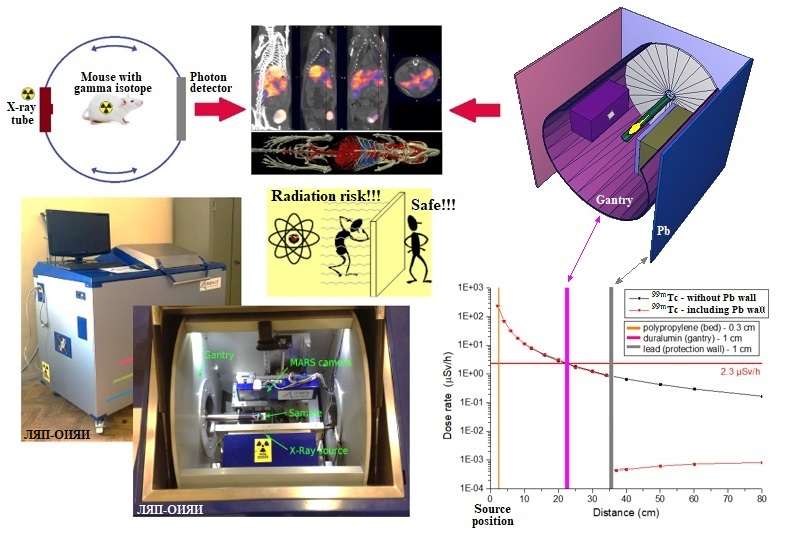A code system based on the Monte Carlo method will be used to simulate the interaction of radiation with matter, to study radiation shielding in a selected medical application: a preclinical SPECT/CT scanner. In the simulation, the most important components of the scanner, with their typical materials and dimensions, will be taken into consideration. Some of the most widely used radioisotopes in SPECT imaging (201Tl, 133Xe, 99mTc, 131I, etc.) will be used as gamma sources. Interesting will be the simulation in the CT geometry of a Roentgen X-ray tube emitting strictly with the characteristic spectrum that corresponds to the selected anode (W) and the tube operating parameters. Taking into consideration that the safe operation of the scanner by technical and medical personnel must comply with the radiation protection requirements demanded at the international level, the calculated dose rates for different conditions will be compared with the limit values of safe dose rates established for each group of people. The results will be analyzed in detail in the project.
Tasks
1. Study of methods for mathematical modeling of radiation interaction with matter.
2. Familiarization with SPECT and CT imaging techniques.
3. Determination from the literature of the safe exposure dose limits for occupationally exposed personnel and patients.
4. Preparation or adjustment of the MCNPX input files for the calculations, including the conversion of the obtained fluence data to dose rate units.
5. Calculation by mathematical modeling of the dose rate spatial distribution in the experimental system for typical sources and different radiation protection conditions.
6. Analysis of the results.
7. Preparation of Final Report.
Preliminary schedule by topics/tasks
The expected project duration is 5-6 weeks.
The work schedule will follow the order of the tasks indicated above, admitting the student initiative.
In order to efficiently execute task 4, it will be carried out by taking as reference several existing input files, to which the student must make some adjustments according to the supervisor's instructions.
Most of the time will be dedicated to calculating and analyzing the results, leaving the last week for the Report preparation. The final schedule will be agreed directly with the student.
Required skills
Obligatory: General Physics and courses on Nuclear Physics. Some experience using any version of the MCNP code system for modeling the radiation transport in matter.
Desirable: Knowledge of the mechanisms of ionizing radiation interaction with matter, knowledge of the Monte Carlo Method and its use in Nuclear and Medical Physics, and computing skills.
Satisfactory communication in English, Russian, or Spanish language.
Acquired skills and experience
Understanding the fundamentals of some advanced medical imaging techniques based on Nuclear Physics applications.
Application of mathematical simulation techniques to solve applied problems of radiological protection.
Deepening the knowledge of the radiation with matter interaction mechanisms.
Familiarization with radiation terms and units.
Improve the knowledge in the use of specific software for the scientific results processing and presentation.
Increased experience in the preparation and defense of scientific reports.
Recommended literature
- Hooshang Nikjoo, et al., Interaction of Radiation with Matter, CRC Press, 1st edition (September 30, 2020).
- C-K Chris Wang, Atoms, Nuclei, and Interactions of Ionizing Radiation with Matter, (1st edition), Cognella Academic Publishing, (2016).
- Brian F. Hutton, The Origins of SPECT and SPECT/CT, European Journal of Nuclear Medicine and Molecular Imaging 41(1), 3, (2014).
- John S. Hendricks, et al., LA-UR-08-2216, MCNPX 2.6.0 Extensions, Los Alamos National Laboratory, April 11 (2008).
- International Commission on Radiological Protection, ICRP-103 The 2007 Recommendations of the International Commission on Radiological Protection, JAICRP 37, (2007).
- International Commission on Radiological Protection, Conversion coefficients for use in radiological protection against external radiation, ICRP publication 116, Annals of the ICRP 40, Pergamon Press Oxford (2010).




